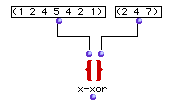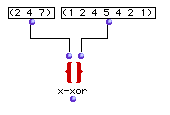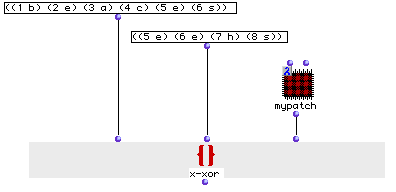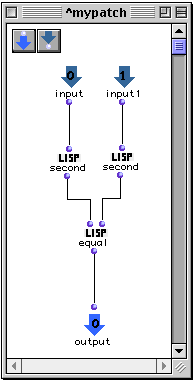OpenMusic Reference
x-xor

x-xor
(sets module) -- performs a XOR (exclusive OR on two or more lists
Syntax
x-xor l1? l2? &optional test key &rest list
Inputs
| name | data type(s) | comments |
|---|---|---|
| l1? | a list or tree | |
| l2? | a list or tree | |
| test | a function name or lambda function | optional; the function with which to compare the two lists. Defaults to ‘equal’ |
| key | a function name or lambda function | optional; a function to apply to the lists before comparison. Defaults to ‘identity’ |
| list | list | optional, extensible; additional lists to be compared. |
Output
output| data type(s)| comments
—|—|—
first| a list| a single list, containing the elements present in l1? or
l2? but not both. If used with list , returns any elements present in
only one of l1? , l2? and any list s.
Description
Normally, this box performs the logical operation XOR . On two sets. XOR is a predicate which returns t when either, but not both, of its inputs are true, unlike the simple OR function, which will return t whenever either of the inputs are true. XOR is an abbreviation of “exclusive OR”.
Elements of the two sets are XORed, meaning the set returned has elements appearing in either one or the other set, but not both.
If the optional test argument is added, the lists can be compared according to any predicate. The default value of test is ‘equal. Only elements in either list that return nil in comparison with every element in the other list (according to the predicate) are returned in the result list. Since the default comparison returns t if the elements are equal, only elements which apppear in both lists are eliminated.
If the key argument is included (the default function is identity ), the function at key is first evaluated using each of l1? ‘s and l2? ‘s elements as input, and then the lists are compared according to the test on the results of the function. test and key may be either the name of a predicate function or a connected function or subpatch icon in lambda mode.
Additional lists can be compared by adding list inputs.
 |
This function is not commutative; the list elements will not be compared in the same order if the lists are reversed, and the output, while containing the same elements regardless, will not contain them in the same order. If you need to be sure that the resulting list is always in the same order regardless of input, use the sort. function.
—|—
Examples
XOR ing two sets

This finds the elements belonging to either set but not both: ? OM->(1 5 1 7) . Note the order of the elements.

Here we switch the outputs. The result list has the same elements but in a different order: ? OM->(7 1 5 1) .
Using XOR with a lambda function to compare sublists

In this example we will XOR the two lists, but only as a function of the second element of each sublist. To do this, we open the test input and plug in a lambda function, ‘mypatch’, displayed below::

‘mypatch’ performs equal on the second element of whatever list comes into its two inputs. x-xor will compare each element of l1? with each element of l2? by passing them both to ‘mypatch’ . So x-xor will actually only compare the second element in each sublist. The result will be:
? OM->((1 b) (3 a) (4 c) (7 h))
| Prev | Home | Next |
|---|---|---|
| x-union | Up | OM Class Reference |